Spellbinder and her crew arrived safely in Le Marin, Martinique at 1750 on Saturday 8th December after a 13-day and 6 hour, 2100 nautical mile passage from Mindelo, Sao Vicente, Cape Verde. It has been a fantastic experience – challenging at times, but we all now have a real sense of achievement.
We enjoyed Mindelo and the taste of Africa it gave us. Provisioning was a bit of a challenge and we bought a lot of fresh fruit and vegetables from the local markets, washing it all in Milton sterilising fluid to kill off cockroach eggs and any other unwanted infestations (so far so good). The marina was quite well set up and we enjoyed meeting some of the ARC + crews, although were glad we had chosen to be independent, most of all in terms of flexibility in our departure time. I am also very independently spirited! We ate well in the local restaurants as well as on the marina floating pontoon. As it was, we left a few hours after the ARC + fleet, having re-fueled and having persuaded a testy immigration official to give me my ship’s documents back. Charm, extreme courtesy, a modicum of humour dosed with feigned obsequiousness worked in the end.
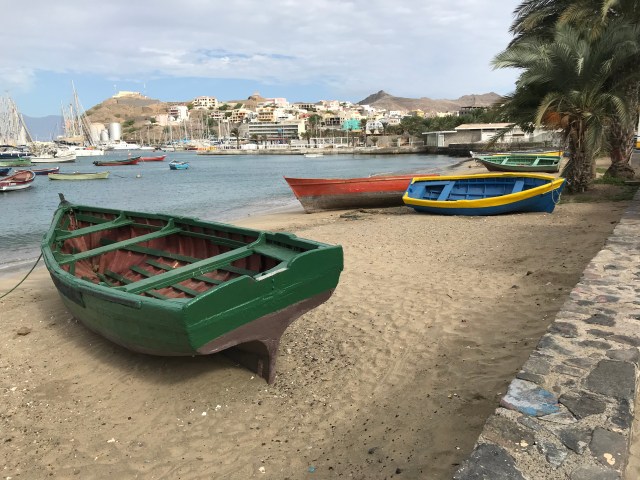
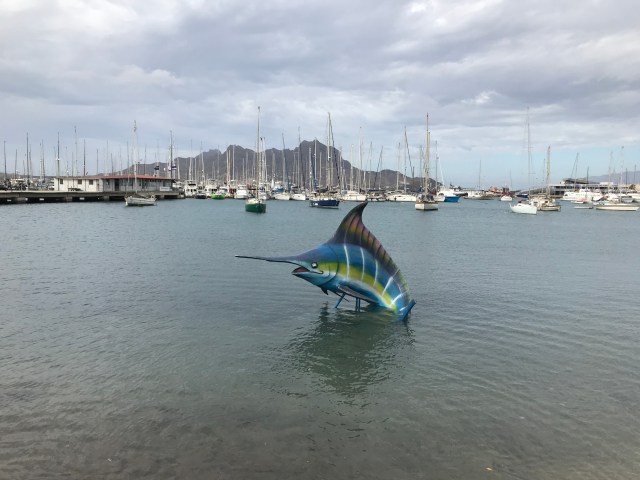
Views of Mindelo

The floating pontoon, Mindelo marina
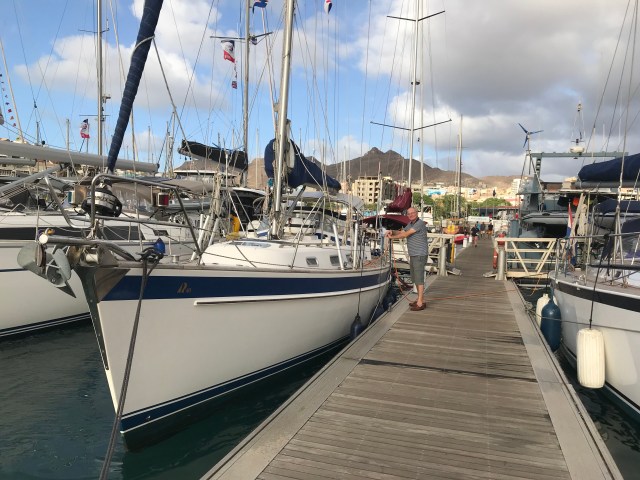
Spellbinder’s berth at Mindelo
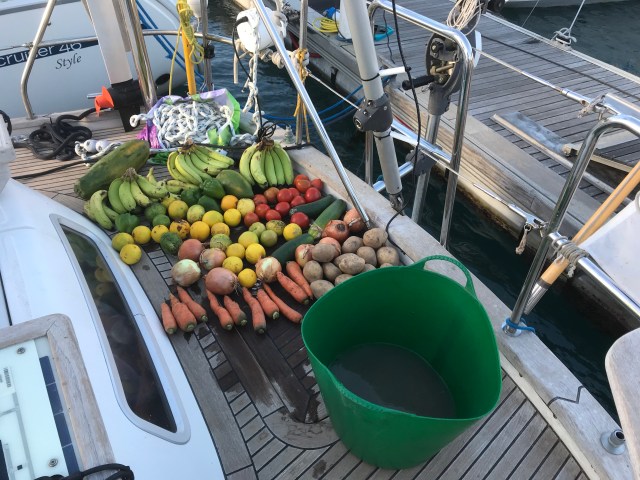
Fresh fruit and vegetables, washed in anti-cockroach egg Milton sterilising fluid
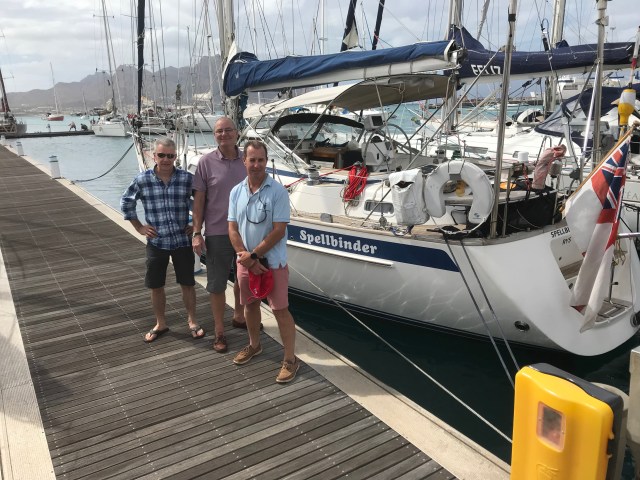
The crew before departure – from left to right Alan, Neil and me. Alan arrived in the Caribbean considerably more facially hirsute!
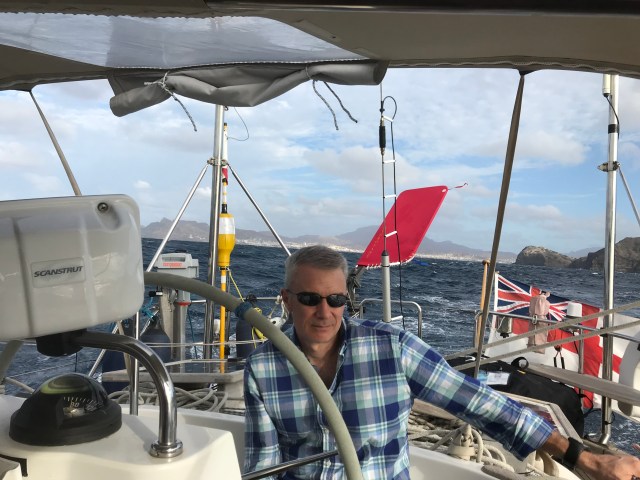
Leaving Mindelo behind
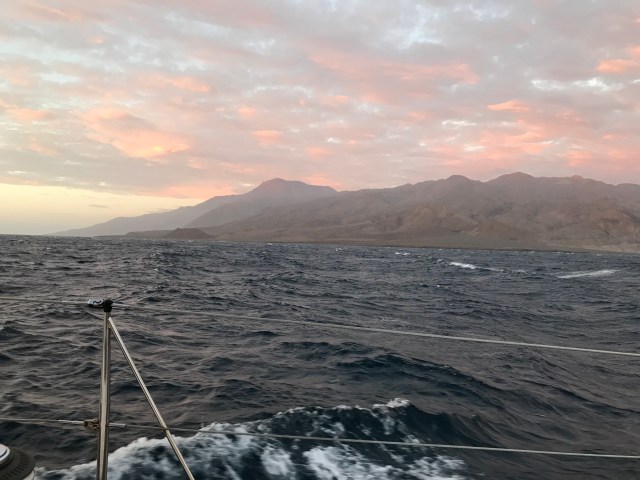
Blustery conditions as we left Cape Verde
We were blessed with reasonably good conditions throughout most of the passage. After a blustery departure through the wind acceleration zone between Sao Vicente and Santo Antão (which saw gusts well into the 30 knot bracket) we settled into what were well-established Trade Winds which varied between 12 to 25 knots, with the average being in the 17-22 knot bracket. The swell at times was significant – 3-4 metres at times although the average was 2 to 3 – but it was largely behind us and although we occasionally fell off a big wave and corkscrewed, for the most part it was an easy motion. We had sun every day with varying amounts of cloud, and the odd light shower, particularly at night. We overtook some of the ARC+ yachts in the early stages but quickly lost track of them.
We goose-winged on starboard tack most of the way, finding it a bit too gusty for the Parasailor until the latest stages of the trip, when it came into its own in lighter airs for a day before being caught out in a squall, necessitating a swift taking down and a future trip to the sailmakers. For the most part we had a reef in the main and genoa, and used the Raymarine Autohelm to steer us in windvane mode (ie keeping a specified angle to the wind) as it kept a straighter line and coped better heading straight downwind. We varied its level of responsiveness until we found the right balance, and although we paid a price in terms of battery drain it served us very well. The Trade Winds served us well until the penultimate day, when they dropped to below 10 knots and we reluctantly had to motor for a few hours.
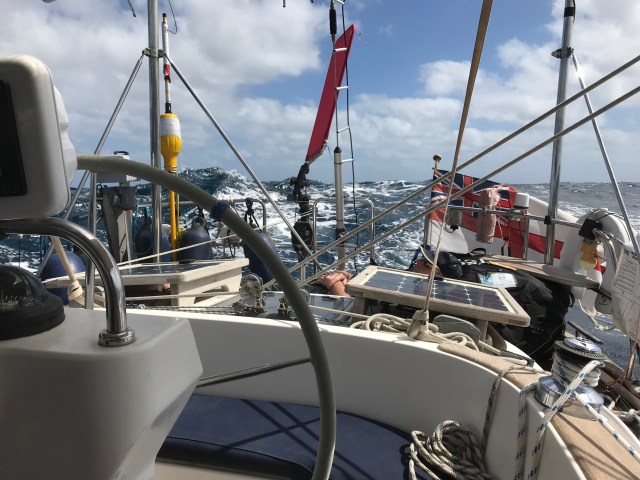
Fairly typical Atlantic rollers coming up behind us. We got used to them and enjoyed the surge they gave Spellbinder every few seconds
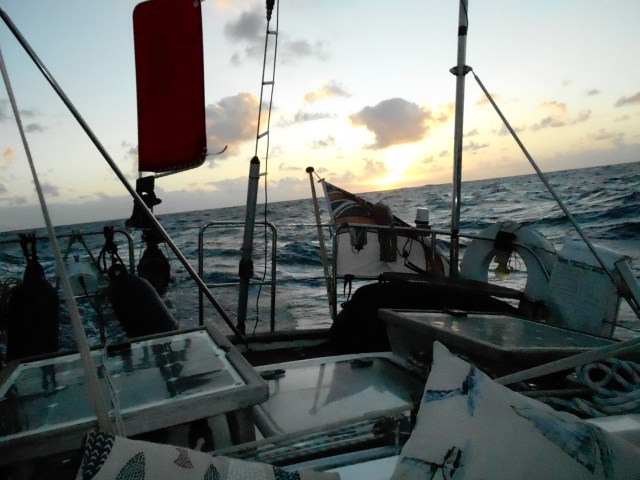
We saw many sunrises astern…
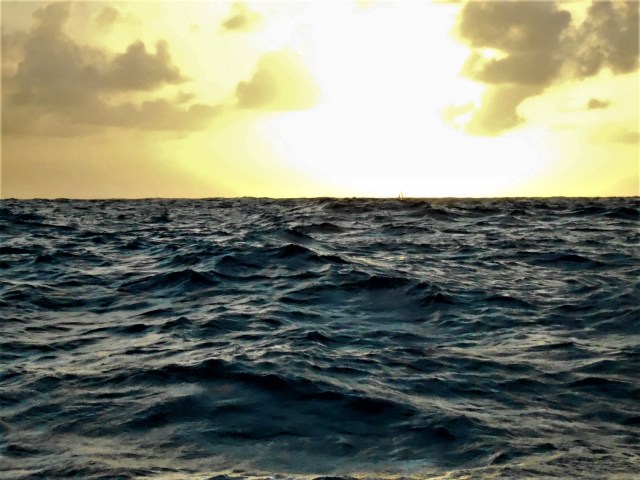
…and many sunsets ahead. No green flashes though. On the horizon, one of the few other yachts we encountered
We settled into a good routine as a crew and took it in turns to cook lunch and dinner, breakfast being a DIY affair according to individuals’ wake up times. We had an informal watch system during the day, with someone always in the cockpit, but at night formalised a ‘2 on – 4 off’ regime with me putting the boat to bed (2000-2200, during which time I used the SSB (HF radio) to write and receive emails, and get GRIB weather files), doing a middle of the night watch (0200-0400) and waking her up (0800). I made sure I did a dawn and dusk ‘patrol’ of the fore deck to look out for chafe and anything untoward, as well as to pick up the self-sacrificing flying fish which greeted me most mornings! Alan and Neil filled in the watches between, swapping around halfway through the passage. Every three days we cleaned the yacht, and every 15 degrees traveled west we put the clocks back by an hour. We ate really well, benefiting from my shopping in Tenerife and the freezer – and we all baked bread and Neil cakes and scones, and magnificent Yorkshire puddings! We ensured we had a drink and nibbles (soft or beer) before lunch and ‘sun downers’ to review the day and look forward to the next. Every 500 miles the gin and tonics came out to make another quarter of the passage completed.
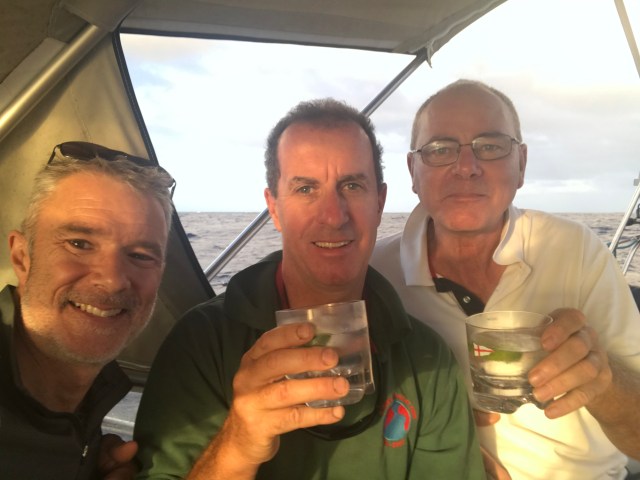
Celebrating another 500 miles sailed
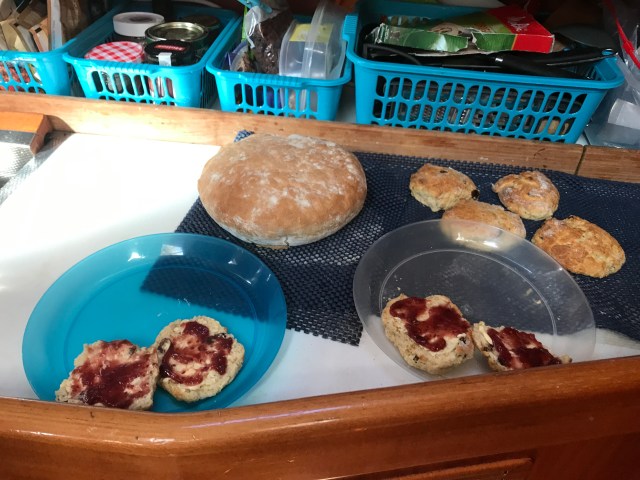
Some fine baking took place – here, bread and scones courtesy of Neil
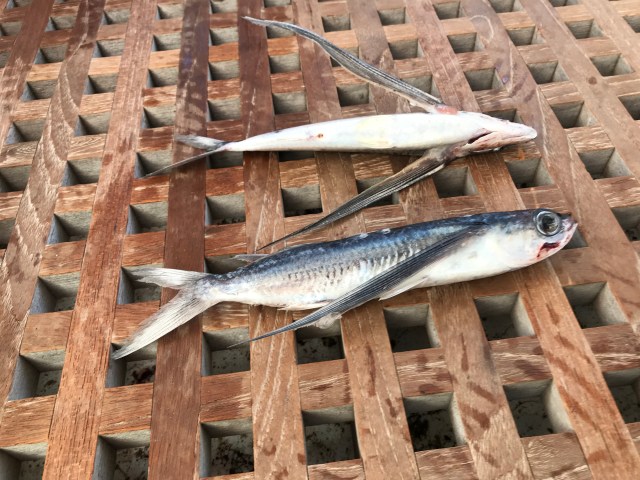
A dawn patrol’s typical flying fish haul
As expected, we spent a fair amount of time mending things. Early on my Aquagen (water electricity generator) lost its towed propeller due either to metal fatigue or just towing something it couldn’t handle – we obviously imagine it was a huge blue marlin! We couldn’t fix this so were obliged to run the engine daily for 2-3 hours to service our electricity needs, which mainly went into refrigeration and autopilot. We also managed to bend the spinnaker pole slightly by tensioning the downhaul too tight, but not to the extent that it impaired performance. We had a heads blockage caused by, of all things, a curtain clip falling into the bowl and occupying a key bend in the pipework (note to self – always keep the bowl shut). I now understand my heads pipework much better! Our main VHF died owing to a blown fuse and me not quite having the right one to replace it (another note to self…) but otherwise it was a case of minor repairs. I have decided that you can never have enough epoxy glue on board…

Pumping out the bilges
Sadly we didn’t see much in terms of wildlife – some distant pilot whale fins but no dolphins or whales. We saw three types of bird in mid-Atlantic – petrels (supremely agile wave hoppers); shearwaters; and my favourite of all tropic birds, with long white tails. Other signs of life were few and far between – the odd yacht with whom we talked on VHF (including a French retired navy gang, and a somewhat ascetic German single-hander called Peter, who was struggling to make 4 knots (complaining about barnacles on his hull) and relied on catching tuna. I also spoke to a Dutch training tall ship called AMSTERDAM – when I talked to the watch officer I discovered he was from Shetland! When you are just a small dot with a horizon of a few miles in the midst of a huge ocean, it is not surprising that you see little evidence of other human life. We saw other AIS ‘contacts’ on the chartplotter but they rarely came into sight.
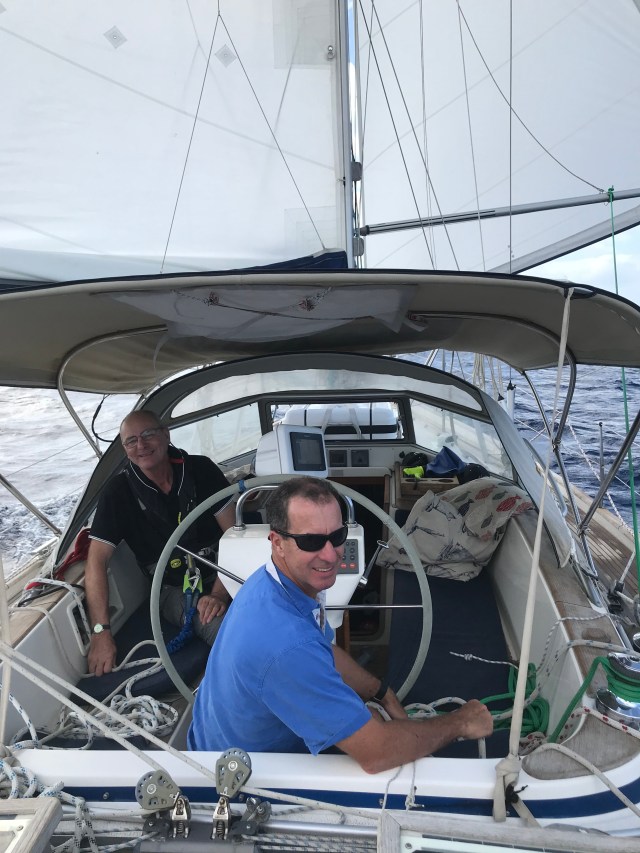
Trade Wind rig
It was a great pleasure making landfall in Martinique, and we cracked open a bottle of champagne once moored up. We are certainly in the Caribbean, but also clearly in France – I had magret de canard washed down with a bottle of Graves last night to celebrate our arrival. We are now in recovery mode, having a day to ourselves before attacking various boat maintenance jobs on Monday. 13 days at an average of 500 steps (according to my watch) means we all need some exercise too! We plan to spend a few days from Tuesday cruising Martinique’s west coast before coming home to UK for Christmas. The temperature change will be a shock…

Arrival in Cul de Sac de Marin

There are advantages to arriving in France. The real Caribbean can wait…
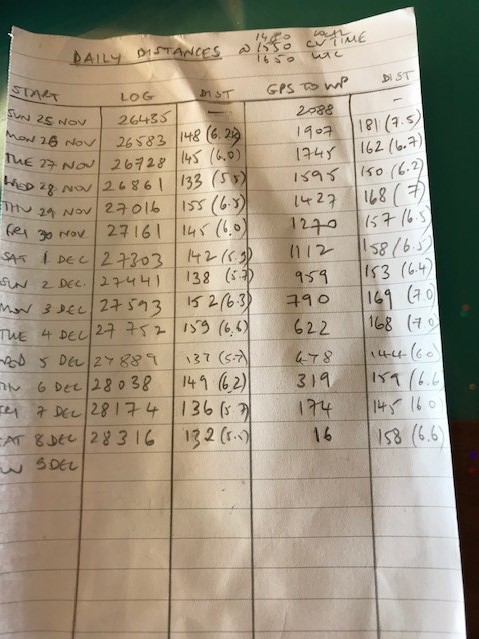
Daily distances through the water (left column) and over the ground (right). We averaged over 150 over the ground, at about 6.5 knots
So, a long-held ambition to sail my own yacht across the Atlantic has been fulfilled for me, and I am delighted. I could not have done so easily without my excellent team – Alan and Neil were just what you need in terms of easy-going, resilient, flexible, reliable and resourceful crew. Thank you to both; it was a great adventure. The Atlantic circuit is now halfway complete.
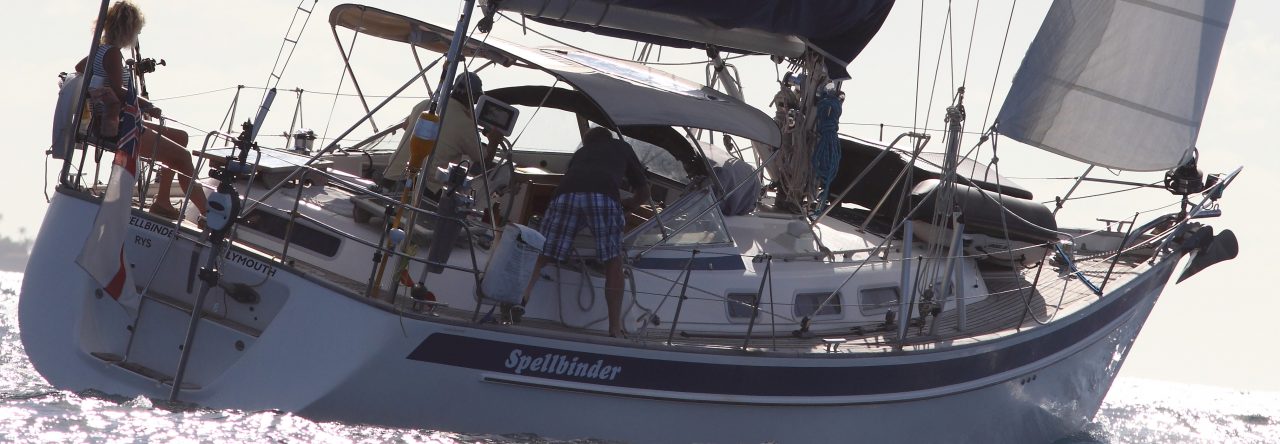
Congrats! Fascinating write up. Sounds like a great crossing. Enjoy the croissants!
LikeLiked by 1 person
Congratulations NIck, Alan and Neil. What an achievement! Time for a week earned rest.
LikeLiked by 1 person
Brilliant, well done Nick and crew!!! What an achievement….you should be very proud indeed of what you have done – and the huge amount of prep that went into it.
LikeLiked by 1 person
Congratulations all. Looking forward to catching up in Jan and planning early March. Safe journey back. David
LikeLiked by 1 person
Congratulations, all. Look forward to catching up in January and planning early March. David
LikeLiked by 1 person
Congratulations sounds fantastic, you’ve got me really inspired to do the same.
LikeLiked by 1 person
Congratulations, sounds like a great trip in very quick time. Enjoy the Caribbean and maybe catch up over Christmas.
LikeLiked by 1 person
Hi Nick,
Very well done on your successful crossing. Great video as well.
Johnny
Sent from my iPad
>
LikeLiked by 1 person
Well done Nick; really good description and tips! One day…,
LikeLike